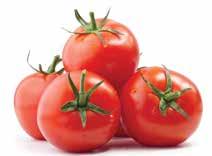
4 minute read
Potatoes NZ Inc
POTATO TUBER MOTH
TARGETED
Words by Glenys Christian
Mulching trial at Pukekawa
Two Pukekawa trials are showing some early promise for potato growers when it comes to greater control of the potato tuber moth, Phthorimaea operculella (PTM).
The pest, which comes from South America and has now been found in over 90 countries, particularly presents a problem around Pukekohe. This is due to the area’s dry, hot summers and mild winters which allow potato growers to leave their crops in the ground from mid-January through to April. But cracks in the volcanic clay soils provide plenty of opportunity for tuber infection by PTM larvae. Organophosphate pesticides have been relied on at the later stages of potato growth for PTM control but due to overuse, environmental impact and increased biological resistance developing, many are now being phased out, says Pukekohe company, Inta-Ag’s chief executive officer, Shane Smith.
Integrated pest management (IPM) strategies have been looked to for the future, but biological controls can be affected by ultraviolet light or rain. While irrigation to prevent the soil becoming dry and cracked is one of a number of cultural methods used, growers face a trade-off with late crop potatoes left in the ground, as they would prefer to use this water on their still growing crops to increase yields, Shane says. IPM programmes are the main focus, but as they are slower to work and often operate at very specific growth stages of the pest, growers and agronomists will need to build up an understanding of how this can be integrated into a future programme, he believes. So Inta-Ag has been running a trial on a potato grower’s land at Pukekawa using straw mulch to see what effect it can have on PTM. Ten tonnes of straw mulch were applied on the one-hectare trial site in October last year and several traps set up to catch PTM as well as TPP (Tomato Potato Psyllid). Shane says he is aware of the mulching technique being used by organic potato growers in the United Kingdom which keeps the soil moisture levels higher as well as preventing the PTM larva getting to potato tubers so easily. Mulching has also brought about several other benefits which were not foreseen, as growers there have noticed fewer weeds in their crops and better disease control, particularly when it comes to sclerotinia.


It is too early yet to tell how effective mulching has been in the Pukekawa trial as full results are expected in April or May when PTM damage can be fully assessed after the potato crop has been in the ground for some time. But Shane says that from his weekly visits to the trial site it already appears that nightshade, potato growers’ worst weed threat, is being kept at bay. When it comes to potential costs for growers looking at straw mulching for their crops, Shane says this needs to be balanced against the expense of using pesticides. And a lot would depend on the price of the straw mulch they used. The potato grower involved in the trial also grew barley, so rather than selling the baled straw was able to use this as mulch, considerably reducing his costs. “A lot of Pukekohe growers are growing barley now as a break crop before onions,” he says. “It depends what will work for each grower.” Some might decide to try the mulching just on their late planted potato crops as well as further fine-tuning crop rotations in line with IPM principles. “There may be a mix of two of three different techniques,” he says. Already there are plans for the trial to be repeated next season over a larger area. Shane hopes that straw mulch can be used on around 20ha spread over two or three different potato growers’ properties, and that it will take in a variety of local areas such as Waiuku where PTM damage can be particularly prevalent. Another PTM trial which is in its first year at Pukekawa is also being run by Inta-Ag. It is looking into the effect of different cover crop mixes sown on potato headlands. Buckwheat, linseed, clover, Phacelia and Smart radish were sown to attract PTM to those areas rather than the potato crop, with the mix possibly being adjusted. There are plans to involve Plant & Food Research to assess exactly what insects are found in the traps later this year. “Already we’ve seen an abundance of insects,” Shane reports. “You notice straight away there are birds swooping down on the headlands and more white butterflies.”
A Potatoes New Zealand literature review of PTM control methods was carried out last year and can be found on its website https://potatoesnz.co.nz/research-and-
development/technical-bulletins/
Annand Propham® Potato Dust | Inhibits sprouts on fresh potatoes
It is a key part of good storage or shipping practice to apply Annand Propham®Potato Dust to prevent sprouting and to keep potatoes fresh,preserve natural flavour, flesh quality and texture.
Easily applied during loading of potatoes Just one treatment is normally sufficient to keep tubers in condition for 8 months at 6–8oC Annand Propham® Potato Dust is packaged in 25kg bags for commercial use

Annand Propham® Potato Dust is an ACVM MPI Registered product P003465 Dianne Perry |Propham® Manager, AB ANNAND & Co Ltd Phone: 03 325 2020 | Mobile: 027 242 2793 | Email: djp@abannand.co.nz | Web: www.abannand.co.nz










